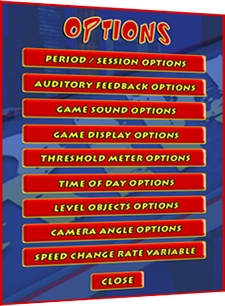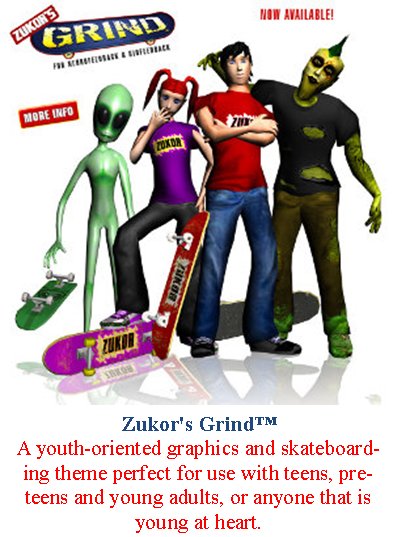
Highly Customizable & Options Galore
Zukor’s Grind offers an unprecedented amount of features, options and customizability to fit the needs of the individual clinician’s feedback training style, as well as the unique needs of each patient. Clinicians frustrated by current feedback games’ lack of options will be amazed to see that Zukor’s Grind has 9 separate areas of options, each of which have up to 55 individual choices.
Clinicians use varied neurofeedback and biofeedback protocols, so feedback games should be flexible as well. Zukor’s Grind does just that and allows the clinician to adjust the game to fit their individual needs. This extensive level of choice and control provide myriad benefits for both clinicians and patients, including those discussed below.

Patient Profiles Clinicians can create feedback game profiles for each patient which will store all feedback game options, settings and scores for that patient in a HIPPA-compliant format. This means the clinician does not have to reset the options each time for each patient. The game will remember what was used last time. What’s more, the Patient Profile includes a “Nickname” feature so each patient can select a fun nickname for themselves which is displayed on the Scores screen.
Period/Session Options Clinicians can easily setup the number of periods per session, the length of each period and the optional Auto-Restart Next Period at a desired time interval
Threshold Meter Options The clinician can separately turn on or off the reward or inhibit meters. Plus, there are five different styles of inhibit meters available, from the approach used in most current games to new meter styles which use more intuitive visual concepts and innovative graphical depictions.
Note: Zukor's Grind licenses are attached to the computer in which they are originally installed, not your EEG Software license. They cannot be moved or transferred to another computer.
MINIMUM COMPUTER SYSTEM REQUIREMENTS
Note: Most computers sold within the last two years will meet these requirements.
Your computer system needs to meet the below requirements to properly run Zukorʼs Grind. Computer systems which donʼt meet these requirements may be able to run the game, but might encounter issues ranging from minor to extreme. Please note that these computer systems requirements are in alignment with those of the neurofeedback/biofeedback system companies.
1. OPERATING SYSTEM
Windows 7 on a regular PC or on a Mac (via Bootcamp).
NOTE: Microsoft no longer supports many versions of Windows XP and Windows Vista.
IMPORTANT: Please make sure you have downloaded and installed ALL Windows 7 updates PRIOR TO INSTALLING and running Zukor's Grind. Failure to do this may lead to improper operation of the game.
2. COMPUTER GRAPHICS REQUIREMENTS
Dedicated graphics card with at least 512 MB dedicated video memory.
NOTE: Systems which do not meet these graphic requirements will still likely play the game, but may require graphic adjustments within the game to reduce graphics quality so the game will play smoothly.
3. MONITORS/DISPLAYS
Two monitors. (Game monitor should be “widescreen” and 21+ inches.)
NOTE 1: A second monitor which meets the above requirements is a very inexpensive investment available from EEG Sales LLC.
NOTE 2: If using a laptop computer, the laptop screen counts as one monitor.
NOTE 3: Video projectors, Plasma TVs and LCD TVs usually work as well, but could require the Windows graphic settings to be adjusted.
Game Display Options The clinician can separately turn off different types of in-game, on-screen displays, such as speed meter, time, scores, etc.
Game Sound Options The clinician can separately turn off different types of in-game environmental sounds, such as skateboarding sounds, character sounds, etc. while not effecting the Reward Waves Sound.
Graphics Configuration Clinicians can adjust the graphics quality lower or higher to meet the capabilities of their specific computer system.
 Levels Clinicians can chose from three unique levels with increasing length and complexity. Zukor’s Grind levels are not just different colored tunnels, background photos or clip art, but rather truly unique, fully-developed and highly-imaginative paths populated by an array of diverse, interesting objects.
Levels Clinicians can chose from three unique levels with increasing length and complexity. Zukor’s Grind levels are not just different colored tunnels, background photos or clip art, but rather truly unique, fully-developed and highly-imaginative paths populated by an array of diverse, interesting objects.
Level Object Options Each of the levels can be modified by the clinician by turning off individual objects, turning off groups of objects or turning off all objects. This allows the clinician to custom-tailor the game to their feedback protocol. It is also a simple way to “dial up or down” the visual stimulation of the game
The objects within the game vary greatly and include real-world and fantasy objects of varying maturity, from juvenile to serious. However, the objects overall are geared towards kids (teens and pre-teens), but many have historical significance. A few objects move, but most are static to reduce distractions. Some emit sound, but most do not.
Time of Day Options The clinician can have the game environment appear as day or night (with moonlight). Another “Time of Day” alternative is the “Moving Sun” mode where the “sun” moves 360 degrees around the “Concrete Paradise” game environment. The “Time of Day” options in Zukor’s Grind, do more than add variety. They offer the clinician a powerful tool to control the “mood” of the game and thus support the desired patient treatment protocol.
Feedback Game Features: Advanced
Auditory Feedback Options Clinicians can select from a broad array of high-quality sounds from both music instruments and synthetic sources, including both a low and high pitch version for each sound. Clinicians can also set the auditory feedback sound’s delay interval in milliseconds. Importantly, the auditory feedback sound volume can be adjusted separately from the game’s environmental sounds. Together these offer total control of the patient’s auditory feedback sound experience.
Speed Change Rate Variable This advanced setting allows clinicians to adjust how dramatically the character responds to changes in EEG or biometric data which can be very useful for certain treatment protocols. The clinician is able to easily change the variable in the gameplay dynamics algorithm which controls the “rate of speed change” of the character. It does not change how “fast” the character responds, but how “much.” Likewise, it also does not change the delay of the speed change because the character always responds instantly to changes in EEG or biometric data. However, the perception will be that if the Speed Change Rate is “more” that the character is responding quicker.
Characters The clinician can chose from human and non-human characters. There is a teenage boy, named Biff, and a teenage girl, named Buffy. The non-human characters are labeled as Bonus Characters but the clinician can select them at any time. These characters are a great way to reward a patient for reaching certain treatment goals.
The Bonus Characters can be hidden on the Characters page so they are not visible as an option until the clinicians is ready to reveal them to the patient.
